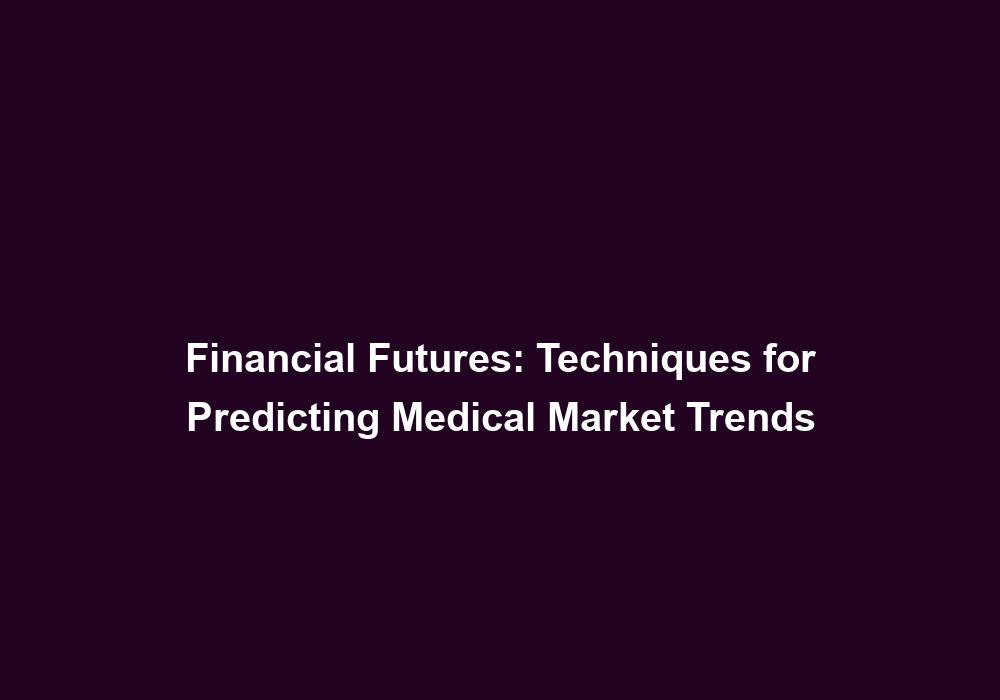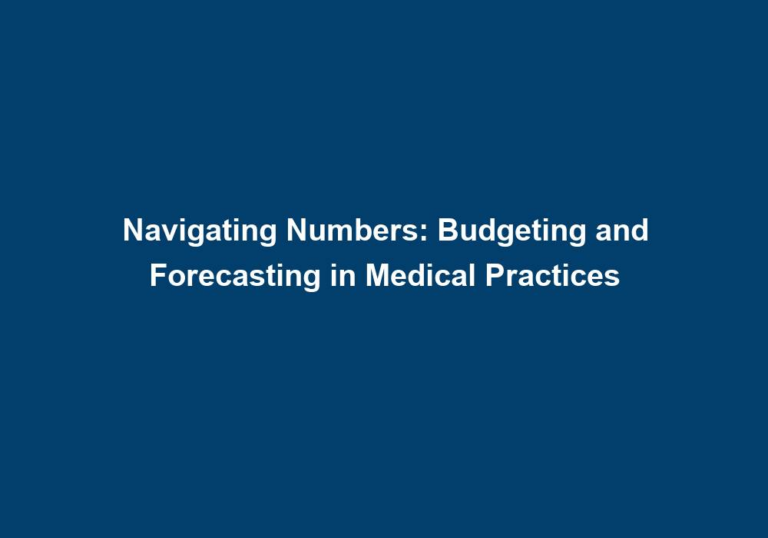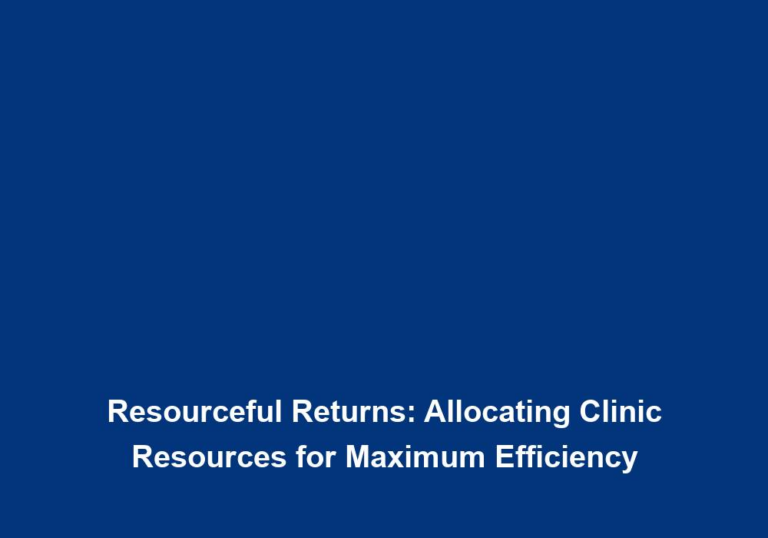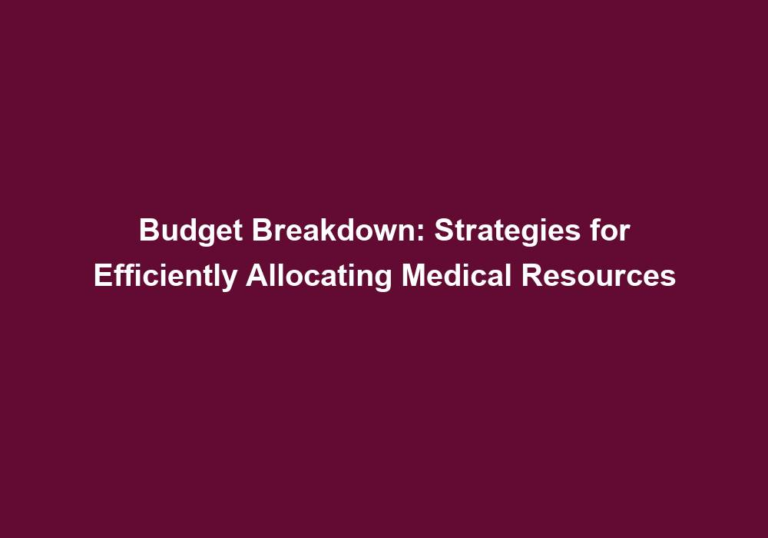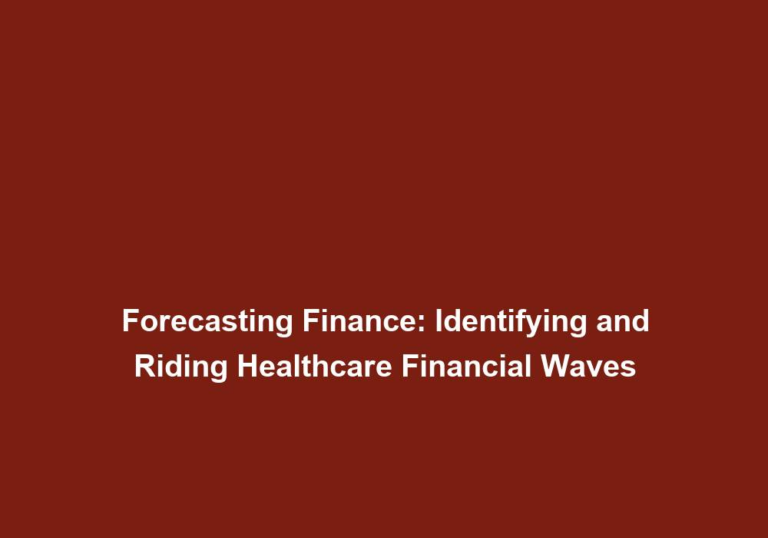Financial Futures: Techniques for Predicting Medical Market Trends
The healthcare industry is a constantly evolving and dynamic sector, influenced by various factors such as technological advancements, regulatory changes, and shifts in patient demographics. To stay ahead in this complex landscape, financial professionals must have a deep understanding of medical market trends and possess effective techniques for predicting future developments. In this article, we will explore some key strategies that can help financial experts anticipate changes in the medical market and make informed investment decisions.
1. Analysis of Demographic Patterns and Aging Population
One of the significant drivers of medical market trends is the demographic composition of the population. As the global population continues to age, the demand for healthcare services and products is expected to rise significantly. Financial professionals can analyze demographic patterns and understand the needs of the aging population to identify potential investment opportunities in sectors such as senior care facilities, pharmaceuticals, and medical devices.
Expanding on this, understanding the specific healthcare needs of the aging population is crucial in predicting market trends. This includes studying the prevalence of chronic diseases, such as diabetes and cardiovascular conditions, which are more prevalent in older individuals. Financial professionals can then identify investment opportunities in companies that focus on developing innovative treatments, medications, and devices for managing these conditions. Additionally, analyzing the geographical distribution of the aging population can help identify regions with higher demand for healthcare services, allowing for targeted investments in healthcare infrastructure and facilities.
Some key considerations for financial professionals when analyzing demographic patterns and the aging population include:
- Identifying the specific healthcare needs of the aging population
- Studying the prevalence of chronic diseases among older individuals
- Analyzing the geographical distribution of the aging population
2. Monitoring Technological Advancements
Technological advancements play a pivotal role in shaping the medical market. From innovative treatment options to advanced medical devices, breakthrough technologies can disrupt established healthcare practices and create new investment avenues. Staying informed about the latest developments in areas like telemedicine, artificial intelligence, precision medicine, and genomics can help financial experts anticipate market trends and identify promising companies or startups that hold the potential for significant growth.
Expanding on this, understanding the potential impact of technological advancements on the medical market is essential. For example, advancements in telemedicine enable remote consultations and monitoring, which can revolutionize the delivery of healthcare services. Financial professionals can identify investment opportunities in companies that develop telemedicine platforms, virtual care solutions, and remote patient monitoring devices. Furthermore, advancements in artificial intelligence and machine learning can improve diagnostic accuracy, personalized medicine, and drug discovery, presenting investment opportunities in companies at the forefront of these technologies.
Some key considerations for financial professionals when monitoring technological advancements include:
- Staying updated on the latest developments in telemedicine, artificial intelligence, precision medicine, and genomics
- Understanding the potential impact of these advancements on healthcare delivery and patient outcomes
- Identifying companies that are at the forefront of developing innovative technologies in healthcare
3. Regulatory Changes and Government Policies
Regulatory changes and government policies have a profound impact on the healthcare industry. Keeping track of legislative developments and understanding their implications is crucial for predicting medical market trends. For instance, changes in reimbursement policies, drug approvals, or telehealth regulations can greatly influence the profitability and growth prospects of healthcare organizations. By staying updated with regulatory updates and analyzing their potential effects, financial professionals can stay ahead of the curve and make informed investment decisions.
Expanding on this, understanding the intricacies of regulatory changes and government policies is vital in predicting market trends. Financial professionals should closely monitor proposed and implemented changes in regulations related to healthcare, such as those pertaining to reimbursement models, clinical trial regulations, and data privacy laws. By understanding the potential impact of these changes, financial professionals can identify investment opportunities in companies that are well-positioned to adapt and thrive in the evolving regulatory landscape.
Some key considerations for financial professionals when analyzing regulatory changes and government policies include:
- Keeping track of proposed and implemented changes in healthcare regulations
- Understanding the potential impact of regulatory changes on healthcare organizations
- Identifying companies that can navigate regulatory challenges and capitalize on emerging opportunities
4. Industry Research and Reports
Another valuable resource for predicting medical market trends is industry research and reports. Various organizations and research institutions regularly publish reports that provide insights into the healthcare industry’s future direction. These reports often analyze market dynamics, emerging technologies, and shifts in consumer behavior. By thoroughly studying these reports and incorporating their findings into investment strategies, financial professionals can gain a comprehensive understanding of the medical market landscape.
Expanding on this, leveraging industry research and reports can provide financial professionals with valuable market intelligence. These reports often delve into specific sectors within the healthcare industry, such as pharmaceuticals, medical devices, or healthcare IT, providing detailed analyses of market trends, growth projections, and competitive landscapes. By incorporating the findings from these reports, financial professionals can identify niche investment opportunities, evaluate market risks, and make data-driven investment decisions.
Some key considerations for financial professionals when utilizing industry research and reports include:
- Accessing reports from reputable organizations and research institutions
- Analyzing market dynamics, growth projections, and competitive landscapes
- Incorporating the findings from these reports into investment strategies
5. Collaboration with Industry Experts
Collaboration with industry experts can provide valuable insights and perspectives on medical market trends. Engaging in discussions, attending conferences, and participating in forums can help financial professionals gain a deeper understanding of the challenges and opportunities within the healthcare sector. By building relationships with healthcare professionals, industry thought leaders, and subject matter experts, financial experts can tap into their knowledge and expertise to enhance their predictive abilities and make informed investment decisions.
Expanding on this, actively engaging with industry experts allows financial professionals to gain a holistic view of the medical market. By participating in conferences and forums, they can stay updated on the latest industry trends, emerging technologies, and regulatory changes directly from experts in the field. These interactions provide networking opportunities and foster collaborations that can lead to valuable insights and potential investment opportunities.
Some key considerations for financial professionals when collaborating with industry experts include:
- Actively participating in industry conferences, forums, and discussions
- Building relationships with healthcare professionals and industry thought leaders
- Seeking expert opinions and insights on market trends and emerging technologies
6. Analyzing Key Performance Indicators (KPIs)
Analyzing key performance indicators (KPIs) is essential for understanding the financial health and growth potential of healthcare organizations. Monitoring metrics such as revenue growth, profit margins, patient volume, and market share can provide valuable insights into the market trends and competitive landscape. By identifying the financial strengths and weaknesses of different companies, financial professionals can assess their investment potential and make informed decisions.
Expanding on this, a comprehensive analysis of KPIs allows financial professionals to assess the financial stability and growth potential of healthcare organizations. By examining revenue growth, profit margins, and patient volume, they can gauge the market demand for a company’s products or services. Additionally, analyzing market share provides insights into a company’s competitive position within the industry. This data-driven approach enables financial professionals to evaluate investment opportunities based on the financial performance and market position of healthcare organizations.
Some key considerations for financial professionals when analyzing key performance indicators include:
- Monitoring metrics such as revenue growth, profit margins, and patient volume
- Analyzing market share to evaluate a company’s competitive position
- Using KPIs to assess the financial health and growth potential of healthcare organizations
Conclusion
Predicting medical market trends in the ever-changing healthcare industry is a challenging task. However, by leveraging various strategies and techniques, financial professionals can enhance their predictive abilities and make informed investment decisions. Analyzing demographic patterns, monitoring technological advancements, staying updated with regulatory changes, conducting thorough industry research, collaborating with industry experts, and analyzing key performance indicators are all crucial aspects of effectively predicting medical market trends. By combining these strategies with a deep understanding of the healthcare landscape, financial professionals can navigate the complexities of the medical market and identify lucrative investment opportunities.

